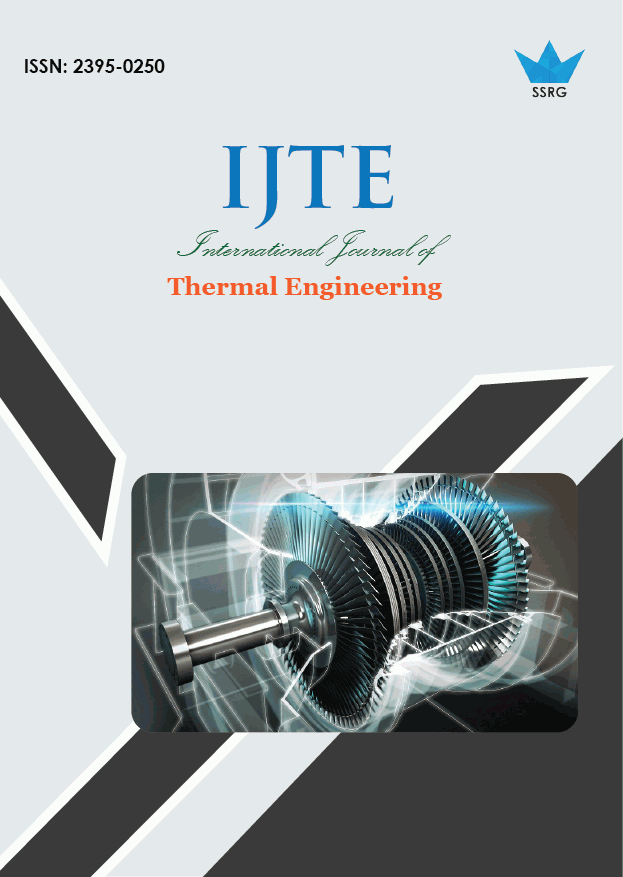Diesel Engine Waste Heat Harnessing ORC

| International Journal of Thermal Engineering |
| © 2020 by SSRG - IJTE Journal |
| Volume 6 Issue 1 |
| Year of Publication : 2020 |
| Authors : Simon Taylor, James Bull, James M. Buick, Jovana Radulovic |
How to Cite?
Simon Taylor, James Bull, James M. Buick, Jovana Radulovic, "Diesel Engine Waste Heat Harnessing ORC," SSRG International Journal of Thermal Engineering, vol. 6, no. 1, pp. 29-35, 2020. Crossref, https://doi.org/10.14445/23950250/IJTE-V6I1P103
Abstract:
Use of ORCs in waste heat recovery is widely seen as a viable and promising solution for increasing energy efficiency and emission reduction efforts, with “on-board” vehicular concepts becoming increasingly popular. In this study, the potential of an ORC harnessing exhaust energy from a diesel generator is considered. Preliminary fluid selection was based on satisfactory thermodynamic performance, and expander size requirement as the limiting parameter. Both simple and recuperative ORC systems were modelled. The effect of the exhaust temperature and the high operational pressure of the ORC model were evaluated in terms of energetic and exergetic performance. For the toluene ORC, moderate pressure values were dictated by the expander size limitation, yet this can be alleviated by high exhaust temperatures. Simple ORCs required a larger heat input and had lower exergetic efficiency. Recuperative ORCs showed better thermal efficiency and lower overall exergy destruction. The expander efficiency was identified as a vital parameter for cycle design and thermodynamic performance.
Keywords:
Organic Rankine cycle; exergetic efficiency; volume ratio
References:
[1] B.F. Tchanche, Gr. Lambrinos, A. Frangoudakis, and G. Papadakis, “Low-grade heat conversion into power using organic Rankine cycles – A review of various applications,” Renewable and Sustainable Energy Reviews, vol. 15, pp. 3963-3979, 2011.
[2] S. Quoilin, M. Van den Broek, S. Declaye, P. Dewallef, and V. Lemont, “Techno-economic survey of Organic Rankine Cycle (ORC) systems,” Renewable and Sustainable Energy Reviews, vol. 22, pp. 168-186, 2013.
[3] Y. Zhu, W. Li, J. Li, H. Li, Y. Wang, and S. Li, “Thermodynamic analysis and economic assessment of biomass-fired organic Rankine cycle combined heat and power system integrated with CO2 capture,“ Energy Conversion and Management, vol. 2014, pp. 112310, 2020.
[4] B. Kölsch, and J. Radulovic, “Utilisation of diesel engine waste heat by Organic Rankine Cycle,” Applied Thermal Engineering, vol. 78, pp. 437-448, 2015.
[5] T. Chen, W. Zhuge, Y. Zhang, and L. Zhanga, “A novel cascade organic Rankine cycle (ORC) system for waste heat recovery of truck diesel engines, “ Energy Conversion and Management, vol. 138, pp. 210-223, 2017.
[6] W.R. Huster, Y. Vaupel, A. Mhamdi, and A. Mitsos, “Validated dynamic model of an organic Rankine cycle (ORC) for waste heat recovery in a diesel truck,” Energy, vol. 151, pp.647-661, 2018.
[7] J. Jannatkhah, B. Najafi, and H. Ghaebi, “Energy and exergy analysis of combined ORC – ERC system for biodiesel-fed diesel engine waste heat recovery,” Energy Conversion and Management, vol. 209, pp 112658, 2020.
[8] P. Liu, G. Shu, and H. Tian, “How to approach optimal practical Organic Rankine cycle (OP-ORC) by configuration modification for diesel engine waste heat recovery,” Energy, vol. 174, pp. 543-552, 2019.
[9] A.G. Mohammed, M. Mosleh, W.M. El-Maghlany, and N. R. Ammar, “Performance analysis of supercritical ORC utilizing marine diesel engine waste heat recovery”, Alexandria Engineering Journal, vol. 59, pp. 893-904, 2020.
[10] U. Larsen, L. Pierobon, F. Haglind, and C. Gabrielii, “Design and optimisation of organic Rankine cycles for waste heat recovery in marine applications using the principles of natural selection,” Energy, vol. 55, pp. 803-812, 2013.
[11] G. Yu, G. Shu, H. Tian, H. Wei and L. Liu, “Simulation and thermodynamic analysis of a bottoming Organic Rankine Cycle (ORC) of diesel engine (DE),” Energy, vol. 51, pp. 281-290, 2013.
[12] X. Wang, X. Liu, and C. Zhang, “Parametric optimization and range analysis of Organic Rankine Cycle for binary-cycle geothermal plant,” Energy Conversion and Management, vol. 80, pp. 256-265, 2014.
[13] C.O. Katsanos, D.T. Hountalas, and E.G. Pariotis, “Thermodynamic analysis of a Rankine cycle applied on a diesel truck engine using steam and organic medium,” Energy Conversion and Management, vol. 60, pp. 68-76, 2012.
[14] R. Capata, and C. Toro, “Feasibility analysis of a small-scale ORC energy recovery system for vehicular application,” Energy Conversion and Management, vol. 86: pp. 1078-1090, 2014.
[15] J. Song, Y. Song, and C.-w. Gu, “Thermodynamic analysis and performance optimization of an Organic Rankine Cycle (ORC) waste heat recovery system for marine diesel engines,” Energy, vol. 82, pp. 976-985, 2015.
[16] J. Radulovic, and N.I. Beleno Castaneda, “On the potential of zeotropic mixtures in supercritical ORC powered by geothermal energy source,” Energy Conversion and Management, vol. 88, pp. 365-371, 2014.
[17] J.R. Bull, J.M. Buick, and J. Radulovic, “Heat Exchanger Analysis for Biomass-Powered Organic Rankine Cycle,” Journal of Alternative and Renewable Energy Sources, vol. 6, pp 1-10, 2020
[18] D. Maraver, J. Royo, V. Lermont, and S. Quoilin, “Systematic optimization of subcritical and transcritical organic Rankine cycles (ORCs) constrained by technical parameters in multiple applications,” Applied Energy, vol. 117, pp. 11-29, 2014.
[19] F. Yang, X. Dong, H. Zhang, Z. Wang, K. Yang, J. Zhang. E. Wang, H. Liu, and G. Zhao, “Performance analysis of waste heat recovery with a dual loop organic Rankine cycle (ORC) system for diesel engine under various operating conditions,” Energy Conversion and Management, vol. 80, pp. 243-255 2014.
[20] P. Gao, L. Jiang, L. W. Wang, R. Z. Wang, and F. P. Song, “Simulation and experiments on an ORC system with different scroll expanders based on energy and exergy analysis,” Applied Thermal Engineering, vol. 75, pp. 880-888, 2015.

 10.14445/23950250/IJTE-V6I1P103
10.14445/23950250/IJTE-V6I1P103